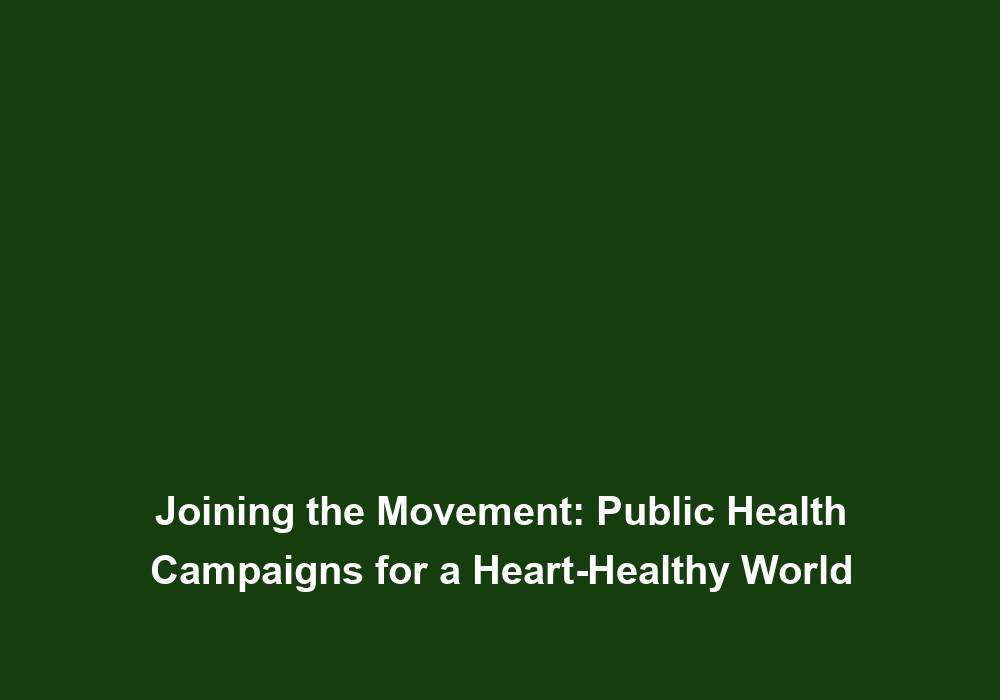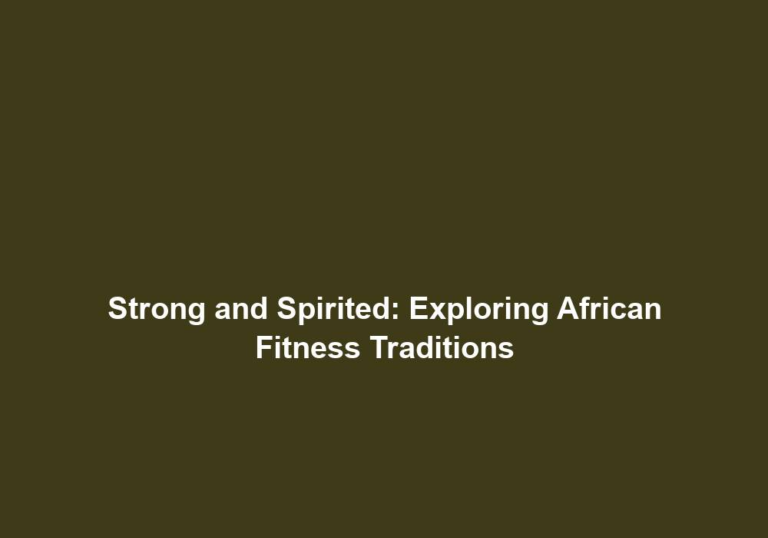Joining the Movement: Public Health Campaigns for a Heart-Healthy World
With the growing concern over heart diseases and their impact on global health, public health campaigns play a vital role in raising awareness and promoting heart-healthy lifestyles. These campaigns aim to educate individuals about the risk factors associated with cardiovascular diseases, encourage healthy behaviors, and provide support for those affected. By joining the movement, we can collectively work towards creating a heart-healthy world.
The Need for Public Health Campaigns
Cardiovascular diseases, including heart attacks and strokes, are the leading cause of death worldwide. According to the World Health Organization, an estimated 17.9 million lives are lost each year due to these conditions. The alarming prevalence of heart diseases calls for immediate action through public health campaigns.
Raising Awareness
One of the primary objectives of public health campaigns is to raise awareness about heart diseases. By highlighting the risks and consequences associated with cardiovascular conditions, these campaigns educate individuals about the importance of preventive measures and early detection. Through various channels, such as social media, television, and community events, campaigns reach a wide audience and instill knowledge about heart health.
Raising awareness about heart diseases is crucial because early intervention can save lives. Many people are unaware of the signs and symptoms of heart diseases, and public health campaigns bridge this knowledge gap. By educating individuals about the warning signs, such as chest pain, shortness of breath, and fatigue, these campaigns empower people to seek medical help promptly. Additionally, campaigns also shed light on the risk factors that contribute to heart diseases, such as high blood pressure, high cholesterol, smoking, obesity, and diabetes. By understanding these risk factors, individuals can take proactive steps to modify their lifestyle and reduce their chances of developing cardiovascular conditions.
Promoting Healthy Lifestyles
Public health campaigns focus on promoting heart-healthy behaviors to reduce the risk of developing cardiovascular diseases. They emphasize the significance of regular physical activity, maintaining a balanced diet, managing stress levels, and avoiding tobacco and excessive alcohol consumption. By advocating for healthy choices, these campaigns aim to empower individuals to take control of their own heart health.
Regular physical activity is a cornerstone of a heart-healthy lifestyle. Public health campaigns encourage individuals to engage in at least 150 minutes of moderate-intensity aerobic exercise or 75 minutes of vigorous-intensity aerobic exercise per week. They emphasize the importance of activities such as brisk walking, jogging, swimming, cycling, and dancing. By incorporating these activities into their daily routine, individuals can strengthen their heart and improve overall cardiovascular fitness.
A balanced diet is also crucial for maintaining heart health. Public health campaigns promote the consumption of fruits, vegetables, whole grains, lean proteins, and healthy fats while limiting the intake of saturated and trans fats, sodium, and added sugars. They educate individuals about portion control, mindful eating, and the importance of reading food labels. By making informed food choices, individuals can lower their risk of developing heart diseases and maintain a healthy weight.
Stress management is another key component of a heart-healthy lifestyle. Public health campaigns highlight the detrimental effects of chronic stress on the cardiovascular system and provide strategies for stress reduction. These strategies may include relaxation techniques, mindfulness practices, regular exercise, adequate sleep, and seeking social support. By managing stress effectively, individuals can protect their heart health and improve their overall well-being.
Successful Public Health Campaigns
Several noteworthy public health campaigns have made significant contributions to raising awareness and improving heart health worldwide. Let’s explore some of them:
1. American Heart Association’s Go Red for Women
Go Red for Women, launched by the American Heart Association, aims to raise awareness about cardiovascular diseases among women. This campaign focuses on dispelling the myth that heart diseases predominantly affect men and highlights the alarming statistics of women’s heart health. By encouraging women to prioritize their heart health through regular check-ups, healthy eating, and physical activity, Go Red for Women has successfully empowered countless women to make positive lifestyle changes.
The Go Red for Women campaign recognizes the unique risk factors and symptoms of heart diseases in women. It educates women about the signs they should be aware of, such as chest pain, shortness of breath, nausea, and jaw pain. The campaign also emphasizes the importance of regular check-ups, as women may experience different symptoms than men and may require specialized medical attention. By providing this targeted information, Go Red for Women ensures that women are equipped with the knowledge they need to protect their heart health.
2. World Heart Federation’s World Heart Day
World Heart Day, celebrated on September 29th each year, is an initiative by the World Heart Federation. This global campaign promotes heart-healthy lifestyles and encourages individuals to invest in their cardiovascular well-being. With a focus on preventative measures, World Heart Day highlights the importance of regular exercise, healthy eating habits, and avoiding risk factors such as smoking. Through various events and activities, this campaign unites people worldwide in their commitment to reducing the burden of heart diseases.
World Heart Day serves as a powerful platform for raising awareness about heart diseases on a global scale. It brings together individuals, organizations, healthcare professionals, and policymakers to advocate for heart health. The campaign provides resources, such as educational materials, toolkits, and digital content, to facilitate the dissemination of accurate information. By leveraging the collective efforts of individuals and organizations, World Heart Day creates a significant impact and inspires positive change in communities around the world.
How to Get Involved
Individuals can actively participate in public health campaigns and contribute to creating a heart-healthy world. Here are some ways to get involved:
1. Spread the Word
By sharing information about public health campaigns on social media platforms or through community networks, you can help raise awareness and reach a wider audience. Use the power of your voice to educate others about the importance of heart health and the resources available through these campaigns.
Spread the word about public health campaigns by sharing relevant articles, infographics, and videos on platforms such as Facebook, Twitter, Instagram, and LinkedIn. Engage with the content by adding personal experiences, testimonials, or tips related to heart health. Encourage your friends, family, and followers to share the information further, amplifying the reach of the campaign’s message. Additionally, consider joining online communities or forums where you can contribute to discussions about heart health and provide support to individuals seeking guidance.
2. Volunteer
Joining local organizations or charities that support heart health initiatives allows you to actively contribute to public health campaigns. You can volunteer your time and skills to assist in organizing awareness events, fundraising efforts, or educational programs focused on heart health.
Contact local hospitals, community centers, or non-profit organizations to inquire about volunteer opportunities related to heart health. Offer your assistance in organizing health fairs, blood pressure screenings, or fitness workshops. You can also contribute by creating informative materials, designing promotional materials, or providing administrative support. By volunteering, you not only contribute to the success of public health campaigns but also gain firsthand experience and knowledge about heart diseases and prevention strategies.
3. Be a Role Model
Leading by example is a powerful way to inspire others. Adopt heart-healthy habits in your own life and demonstrate how simple lifestyle changes can have a significant impact on heart health. Encourage your friends, family, and colleagues to join you in making positive choices for their cardiovascular well-being.
Make heart-healthy choices a part of your daily routine and incorporate them into your lifestyle. Engage in regular physical activity and invite others to join you for walks, hikes, or exercise classes. Cook nutritious meals and share recipes with others to promote healthy eating habits. Manage stress effectively and encourage open conversations about mental well-being. By being a role model, you inspire those around you to prioritize their heart health and make positive changes in their lives.
Conclusion
Public health campaigns are essential in the fight against cardiovascular diseases. By raising awareness, promoting healthy behaviors, and providing support, these campaigns empower individuals to prioritize their heart health. Joining the movement for a heart-healthy world requires collective action and individual commitment. Let us unite, spread the message, and make a meaningful difference in the lives of millions by actively participating in public health campaigns. Together, we can create a future where heart diseases are significantly reduced, and heart-healthy lifestyles become the norm.







